

Beira (mythology) According to Mackenzie, Beira was a one-eyed giantess with white hair, dark blue skin, and rust-colored teeth.

She built the mountains of Scotland using a magic hammer, and Loch Ness was created when Beira transformed her negligent maid Nessa into a river, which broke loose and made the loch. Ben Nevis was her "mountain throne". Baobhan sith. A baobhan sith (pronounced baa'-van shee) is a type of blood-sucking female fairy in Scottish mythology, similar to the banshee or leanan sídhe.

Also known as "the White Women of the Scottish Highlands," [1] they are beautiful seductresses who prey on young travelers by night. Description and attributes[edit] Cailleach. Warrior. A warrior is a person specializing in combat or warfare, especially within the context of a tribal or clan-based society that recognizes a separate warrior class or caste.

Warrior classes in tribal culture[edit] In tribal societies engaging in endemic warfare, warriors often form a caste or class of their own. Scáthach. Scáthach is a figure in the Ulster Cycle of Irish mythology.
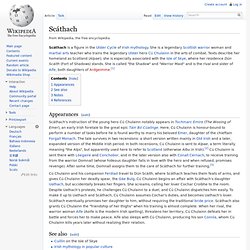
She is a legendary Scottish warrior woman and martial arts teacher who trains the legendary Ulster hero Cú Chulainn in the arts of combat. Texts describe her homeland as Scotland (Alpae); she is especially associated with the Isle of Skye, where her residence Dún Scáith (Fort of Shadows) stands. Am Fear Liath Mòr. Am Fear Liath Mòr (Scottish Gaelic pronunciation: [əm fɛɾ ʎiə moːɾ]; also known as the Big Grey Man of Ben MacDhui or simply the Greyman) is the name of a presence or creature which is said to haunt the summit and passes of Ben Macdui, the highest peak of the Cairngorms and the second highest peak in Scotland (and also in the British Isles).[1] Description[edit] It has been described as an extremely tall figure covered with short hair, or as an unseen presence that causes uneasy feelings in people who climb the mountain.[2] Evidence of the existence of this creature is limited to various sightings and a few photographs of unusual footprints.[2]
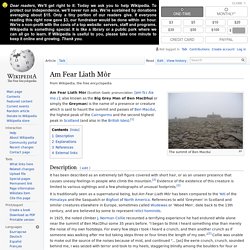
Gray wolf. The gray wolf or grey wolf (Canis lupus) is a canid native to the wilderness and remote areas of North America, Eurasia, and North Africa.
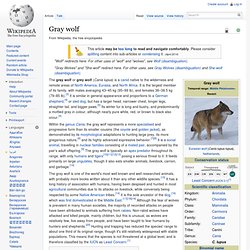
It is the largest member of its family, with males averaging 43–45 kg (95–99 lb), and females 36–38.5 kg (79–85 lb).[3] It is similar in general appearance and proportions to a German shepherd,[4] or sled dog, but has a larger head, narrower chest, longer legs, straighter tail, and bigger paws.[5] Its winter fur is long and bushy, and predominantly a mottled gray in colour, although nearly pure white, red, or brown to black also occur.[4] Etymology The English word "wolf" stems from the Old English wulf, which is itself thought to be derived from the Proto-Germanic *wulfaz, from the Proto-Indo-European root *wlqwos/*lukwos.[21] Old English literature contains several instances of Anglo-Saxon kings and warriors taking on wulf as a prefix or suffix in their names.
Evolution and taxonomy Origins Ancestry Subspeciation Colonization of North America Subspecies. Brigid. This article refers to the Pagan Goddess Brigid.

Triple Goddess (Neopaganism) The Triple Goddess is the subject of much of the writing of Robert Graves, and has been adopted by many neopagans as one of their primary deities.
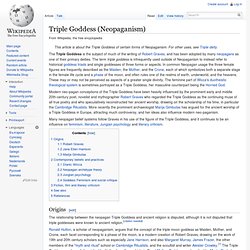
The term triple goddess is infrequently used outside of Neopaganism to instead refer to historical goddess triads and single goddesses of three forms or aspects. In common Neopagan usage the three female figures are frequently described as the Maiden, the Mother, and the Crone, each of which symbolizes both a separate stage in the female life cycle and a phase of the moon, and often rules one of the realms of earth, underworld, and the heavens. These may or may not be perceived as aspects of a greater single divinity. The feminine part of Wicca's duotheistic theological system is sometimes portrayed as a Triple Goddess, her masculine counterpart being the Horned God. The relationship between the neopagan Triple Goddess and ancient religion is disputed, although it is not disputed that triple goddesses were known to ancient religion. Beast of Gévaudan. The Beast of Gévaudan (French: La Bête du Gévaudan; IPA: [la bɛːt dy ʒevodɑ̃], Occitan: La Bèstia de Gavaudan) is the historical name associated with the man-eating wolf-like animals which terrorised the former province of Gévaudan (modern-day département of Lozère and part of Haute-Loire), in the Margeride Mountains in south-central France between 1764 and 1767.[2] The attacks, which covered an area stretching 90 by 80 kilometres (56 by 50 mi), were said to have been committed by beasts that had formidable teeth and immense tails according to contemporary eye-witnesses.
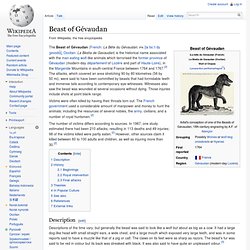
Witnesses also saw the beast was wounded at several occasions without dying. Those injuries include shots at point blank range. Victims were often killed by having their throats torn out. Druid. A druid was a member of the educated, professional class among the Celtic peoples of Gaul, Britain, Ireland, and possibly elsewhere during the Iron Age.
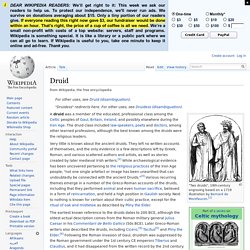
The druid class included law-speakers, poets and doctors, among other learned professions, although the best known among the druids were the religious leaders. Very little is known about the ancient druids. They left no written accounts of themselves, and the only evidence is a few descriptions left by Greek, Roman, and various scattered authors and artists, as well as stories created by later medieval Irish writers.[2] While archaeological evidence has been uncovered pertaining to the religious practices of the Iron Age people, "not one single artefact or image has been unearthed that can undoubtedly be connected with the ancient Druids.
The earliest known reference to the druids dates to 200 BCE, although the oldest actual description comes from the Roman military general Julius Caesar in his Commentarii de Bello Gallico (50s BCE). Satanism. The downward-pointing pentagram is often used to represent Satanism. Satanism is a broad term referring to a group of social movements comprising diverse ideological and philosophical beliefs. Their shared features include symbolic association with, or admiration for the character of Satan, and Prometheus, which are in their view, liberating figures. It was estimated that there were 50,000 Satanists in 1990. There may be as many as one hundred thousand in the world.[1][dead link] Beast of Bray Road. The Beast of Bray Road (or the Bray Road Beast) is a cryptid, or cryptozoological, creature first reported in 1949 on a rural road outside of Elkhorn, Wisconsin.
The same label has been applied well beyond the initial location, to any unknown creature from southern Wisconsin or northern Illinois and all the way to Vancouver Island, Canada, that is described as having similar characteristics to those reported in the initial set of sightings. Bray Road itself is a quiet country road near the community of Elkhorn. The rash of claimed sightings in the late 1980s and early 1990s prompted a local newspaper, the Walworth County Week, to assign reporter Linda Godfrey to cover the story. Godfrey initially was skeptical, but later became convinced of the sincerity of the witnesses. Her series of articles later became a book titled The Beast of Bray Road: Trailing Wisconsin's Werewolf.
Description[edit] Explanations[edit] Lunar effect. Biologists as well as artists and poets have long thought about the Moon's influence on living creatures. A lunar syzygy increases tidal range importantly for some maritime species. Despite all of the beliefs, no valid scientific study has ever found another significant effect of the full Moon on life on Earth. The lunar effect is a real or imaginary correlation between specific stages of the roughly 29.5-day lunar cycle and behavior and physiological changes in living beings on Earth, including humans. Michigan Dogman. The Michigan Dogman is a cryptozoological creature first reported in 1887 in Wexford County, Michigan. Sightings have been reported in several locations throughout Michigan, primarily in the northwestern quadrant of the Lower Peninsula. In 1987, the legend of the Michigan Dogman gained popularity when a disc jockey at WTCM-FM recorded a song about the creature and its reported sightings.
History[edit] In 1987, disc jockey Steve Cook at WTCM-FM in Traverse City, Michigan recorded a song titled "The Legend", which he initially played as an April Fool's Day joke. Spirit possession.